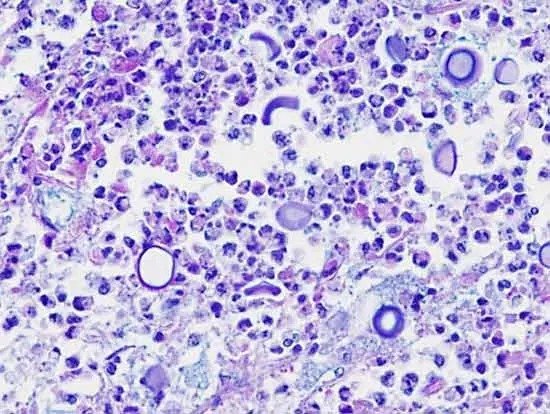Cryptococcus is a type of fungus that is gaining attention worldwide due to its impact on human health. This genus of fungi includes species that can cause serious infections, especially in people with weakened immune systems. The most well-known species are Cryptococcus neoformans and Cryptococcus gattii. These fungi are encapsulated yeasts, meaning they have a thick outer layer called a capsule. This capsule helps the fungus survive in tough conditions and avoid being destroyed by the body’s immune defenses.
Cryptococcus fungi live in the environment, mainly in soil, bird droppings, decaying wood, and trees. Cryptococcus neoformans is often found in urban areas, particularly where there are large populations of pigeons, as the fungus thrives in their droppings. On the other hand, Cryptococcus gattii is more common in tropical and subtropical regions and is linked with certain types of trees. People usually get infected by breathing in tiny spores or yeast cells that are released into the air from these natural sources.
The infection caused by Cryptococcus is called cryptococcosis. It mainly affects the lungs and the central nervous system, including the brain and spinal cord. When the fungus infects the lungs, it can cause symptoms like cough, chest pain, fever, and difficulty breathing. This lung infection can be mild or severe depending on how strong the person’s immune system is. The more dangerous form of the disease occurs when the fungus spreads to the brain, causing cryptococcal meningitis. This condition leads to inflammation of the membranes surrounding the brain and spinal cord. Symptoms of meningitis include headaches, fever, stiff neck, confusion, and can be life-threatening if not treated quickly.
Cryptococcosis most often affects people with weak immune systems. This includes individuals living with HIV/AIDS, organ transplant recipients, cancer patients undergoing chemotherapy, and those taking drugs that suppress the immune system. However, Cryptococcus gattii has been known to infect healthy people as well, making it a concern even for those without obvious risk factors.
To diagnose cryptococcosis, doctors look for the presence of the fungus or its antigens in blood, spinal fluid, or tissue samples. Imaging tests like chest X-rays or CT scans can help detect infections in the lungs or brain. Treatment usually involves antifungal medications such as amphotericin B, flucytosine, and fluconazole. These drugs can be very effective, but treatment often needs to be long and closely monitored, especially when the infection involves the brain.
One growing concern among health experts is the rise of drug resistance. Although most antifungal medications still work against Cryptococcus, resistance to these drugs could make infections harder to treat in the future. Another challenge is the effect of climate change on the spread of fungi like Cryptococcus. Changes in temperature and humidity may allow these fungi to expand into new regions, increasing the risk of infection in areas where the fungus was not previously common.
Cryptococcal meningitis remains one of the leading causes of death among people with AIDS worldwide. This is especially true in parts of sub-Saharan Africa, where access to diagnosis and treatment may be limited. Public health efforts focus on improving early detection, increasing availability of antifungal medicines, and educating vulnerable populations about the risks.
The ability of Cryptococcus to survive in a variety of environments and cause severe illness makes it a significant public health challenge. Its thick capsule protects it from being easily destroyed by the immune system, allowing it to spread and cause serious infections. As more people face weakened immunity due to illnesses or treatments, the threat posed by Cryptococcus grows.
Research continues to improve understanding of how Cryptococcus spreads and how it can be controlled. Scientists are also exploring new antifungal drugs and better diagnostic tools to combat cryptococcosis. Preventing exposure to the spores by managing environments with bird droppings or decaying organic matter is another important strategy to reduce infections.
Overall, Cryptococcus is an important fungal pathogen that demands attention due to its ability to cause life-threatening disease. Monitoring its presence in the environment, improving healthcare responses, and addressing factors like climate change will be key to managing the risks associated with this fungus in the future.







